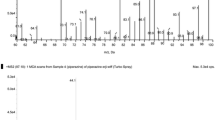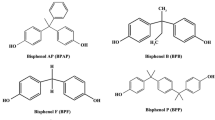Abstract
A rapid, specific, and sensitive method based on modified quick, easy, cheap, effective, rugged, and safe (QuEChERS) coupled to gas chromatography tandem mass spectrometry (GC-MS/MS) was developed and validated for simultaneous determination of chlorpyrifos (CP) and its metabolite 3,5,6-trichloro-2-pyridinol (TCP) in duck muscle. The residues of CP and TCP were extracted by acidified acetonitrile. The fat layer of the extract was removed under −20 °C, then the organic layer was evaporated. The analytes were derivatized by N-(tert-butyldimethylsilyl)-N-methyltrifluoroacetamide (MTBSTFA) and cleaned up by a mixture of 150 mg MgSO4, 25 mg graphitized carbon black (GCB), and 50 mg N-propylethylenediamine (PSA) to remove interference. The final extract was analyzed by GC-MS/MS. Recovery values at the spiking concentrations ranged from 86.2 to 92.3 % for CP and from 74.8 to 81.8 % for TCP, with relative standard deviations (RSDs) lower than 9.5 and 12.3, respectively. The correlation coefficients of CP (from 2 to 2,000 μg/kg) and TCP (from 1 to 1,000 μg/kg) were equal to or higher than 0.998. The limits of detection (LODs) were 0.3 and 0.15 μg/kg, and the limits of quantification (LOQs) were 1.0 and 0.5 μg/kg for CP and TCP in duck muscle, respectively. The average intra- and inter-day accuracy ranged from 84.6 to 91.2 % for CP and 75.6 to 82.3 % for TCP, and the intra- and inter-day precisions were from 5.8 to 8.2 % for CP and 6.5 to 11.9 % for TCP. Furthermore, the CP and TCP residues in duck muscle samples were detected for dietary risk assessment using the validated method.

Simultaneous determination of chlorpyrifos and 3,5,6-trichloro-2-pyridinol residues in duck muscle






Similar content being viewed by others
References
MacLachlan DJ, Bhula R (2008) Estimating the residue transfer of pesticides in animal feedstuffs to livestock tissues, milk and eggs: a review. Aust J Exp Agric 48:589–598
Sogorb MA, Vilanova E, Carrera V (2004) Future applications of phosphotriesterases in the prophylaxis and treatment of organophosporus insecticide and nerve agent poisonings. Toxicol Lett 151(1):219–233
Singh BK, Walker A (2006) Microbial degradation of organophosphorus compounds. FEMS Microbiol Rev 30(3):428–471
Huen K, Bradman A, Harley K, Yousefi P, Boyd Barr D, Eskenazi B, Holland N (2012) Organophosphate pesticide levels in blood and urine of women and newborns living in an agricultural community. Environ Res 117:8–16
Bouchard M, Carrier G, Brunet RC, Bonvalot Y, Gosselin NH (2005) Determination of biological reference values for chlorpyrifos metabolites in human urine using a toxicokinetic approach. J Occup Environ Hyg 2(3):155–168
Hines CJ, Deddens JA (2001) Determinants of chlorpyrifos exposures and urinary 3,5,6-trichloro-2-pyridinol levels among termiticide applicators. Ann Occup Hyg 45(4):309–321
Shemer H, Sharpless CM, Linden KG (2005) Photodegradation of 3,5,6-trichloro-2-pyridinol in aqueous solution. Water Air Soil Pollut 168(1):145–155
Timchalk C, Krieger R (2001) Organophosphate pharmacokinetics. Academic, San Diego, pp 929–952
Busby-Hjerpe AL, Campbell JA, Smith JN, Lee S, Poet TS, Barr DB, Timchalk C (2010) Comparative pharmacokinetics of chlorpyrifos versus its major metabolites following oral administration in the rat. Toxicology 268(1–2):55–63
Caceres T, He W, Naidu R, Megharaj M (2007) Toxicity of chlorpyrifos and TCP alone and in combination to Daphnia carinata: the influence of microbial degradation in natural water. Water Res 41(19):4497–4503
Frenich AG, Bolanos PP, Vidal JL (2007) Multiresidue analysis of pesticides in animal liver by gas chromatography using triple quadrupole tandem mass spectrometry. J Chromatogr A 1153(1–2):194–202
Mol HG, Plaza-Bolanos P, Zomer P, de Rijk TC, Stolker AA, Mulder PP (2008) Toward a generic extraction method for simultaneous determination of pesticides, mycotoxins, plant toxins, and veterinary drugs in feed and food matrixes. Anal Chem 80(24):9450–9459
Gutierrez Valencia TM, Garcia de Llasera MP (2011) Determination of organophosphorus pesticides in bovine tissue by an on-line coupled matrix solid-phase dispersion-solid phase extraction-high performance liquid chromatography with diode array detection method. J Chromatogr A 1218(39):6869–6877
Inman RD, Kiigemagi U, Deinzer ML (1981) Determination of chlorpyrifos and 3,5,6-trichloro-2-pyridinol residues in peppermint hay and peppermint oil. J Agric Food Chem 29(2):321–323
Liang B, Yang C, Gong M, Zhao Y, Zhang J, Zhu C, Jiang J, Li S (2011) Adsorption and degradation of triazophos, chlorpyrifos and their main hydrolytic metabolites in paddy soil from Chaohu Lake, China. J Environ Manage 92(9):2229–2234
Dishburger HJ, McKellar RL, Pennington JY, Rice JR (1977) Determination of residues of chlorpyrifos, its oxygen analogue, and 3,5,6-trichloro-2-pyridinol in tissues of cattle fed chlorpyrifos. J Agric Food Chem 25(6):1325–1329
Williamson LN, Terry AV Jr, Bartlett MG (2006) Determination of chlorpyrifos and its metabolites in rat brain tissue using coupled-column liquid chromatography/electrospray ionization tandem mass spectrometry. Rapid Commun Mass Spectrom 20(18):2689–2695
Juhler RK (1997) Optimized method for the determination of organophosphorus pesticides in meat and fatty matrices. J Chromatogr A 786(1):145–153
Pico Y, Fernandez M, Ruiz MJ, Font G (2007) Current trends in solid-phase-based extraction techniques for the determination of pesticides in food and environment. J Biochem Biophys Methods 70(2):117–131
Miao Q, Kong W, Yang S, Yang M (2013) Rapid analysis of multi-pesticide residues in lotus seeds by a modified QuEChERS-based extraction and GC-ECD. Chemosphere 91(7):955–962
Park KH, Choi JH, Abd El-Aty AM, Cho SK, Park JH, Kwon KS, Park HR, Kim HS, Shin HC, Kim MR, Shim JH (2012) Development of QuEChERS-based extraction and liquid chromatography-tandem mass spectrometry method for quantifying flumethasone residues in beef muscle. Meat Sci 92(4):749–753
Usui K, Hayashizaki Y, Minagawa T, Hashiyada M, Nakano A, Funayama M (2012) Rapid determination of disulfoton and its oxidative metabolites in human whole blood and urine using QuEChERS extraction and liquid chromatography-tandem mass spectrometry. Legal Med (Tokyo) 14(6):309–316
Diaz-Cruz MS, Barcelo D (2006) Highly selective sample preparation and gas chromatographic-mass spectrometric analysis of chlorpyrifos, diazinon and their major metabolites in sludge and sludge-fertilized agricultural soils. J Chromatogr A 1132(1–2):21–27
Hui TJA, Ariffin MM, Tahir NM (2010) Hydrolysis of chlorpyrifos in aqueous solutions at different temperatures and pH. Malays J Anal Sci 14:50–54
Schenck FJ, Hobbs JE (2004) Evaluation of the quick, easy, cheap, effective, rugged, and safe (QuEChERS) approach to pesticide residue analysis. Bull Environ Contam Toxicol 73(1):24–30
Anastassiades M, Mastovska K, Lehotay SJ (2003) Evaluation of analyte protectants to improve gas chromatographic analysis of pesticides. J Chromatogr A 1015(1–2):163–184
Sobhanzadeh E, Nemati K (2013) Liquid-liquid extraction/low-temperature purification (LLE/LTP) followed by dispersive solid-phase extraction (d-SPE) cleanup for multiresidue analysis in palm oil by LC-QTOF-MS. J Chem 2013:1–9
Acknowledgements
This work was supported by grants from Zhejiang Provincial Science and Technology Project (2011C12024), International Cooperation Project of Ministry of Science and Technology (2013DFA31450) and International Cooperation Project of Zhejiang Province (2013C24021).
Author information
Authors and Affiliations
Corresponding authors
Rights and permissions
About this article
Cite this article
Li, R., He, L., Zhou, T. et al. Simultaneous determination of chlorpyrifos and 3,5,6-trichloro-2-pyridinol in duck muscle by modified QuEChERS coupled to gas chromatography tandem mass spectrometry (GC-MS/MS). Anal Bioanal Chem 406, 2899–2907 (2014). https://doi.org/10.1007/s00216-014-7717-8
Received:
Revised:
Accepted:
Published:
Issue Date:
DOI: https://doi.org/10.1007/s00216-014-7717-8




